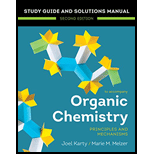
Organic Chemistry: Principles And Mechanisms: Study Guide/solutions Manual (second)
2nd Edition
ISBN: 9780393655551
Author: KARTY, Joel
Publisher: W. W. Norton & Company
expand_more
expand_more
format_list_bulleted
Question
Chapter 10, Problem 10.59P
Interpretation Introduction
Interpretation:
It is to be explained why a terminal
Concept introduction:
Expert Solution & Answer
Want to see the full answer?
Check out a sample textbook solution
Students have asked these similar questions
Draw the complete mechanism for the acid-catalyzed hydration of this alkene.
esc
田
Explanation
Check
1
888
Q
A
slock
Add/Remove step
Q
F4
F5
F6
A
བྲA
F7
$
%
5
@
4
2
3
&
6
87
Click and drag to start
drawing a structure.
© 2025 McGraw Hill LLC. All Rights Reserved. Terms of Use | Privacy Ce
W
E
R
T
Y
U
S
D
LL
G
H
IK
DD
요
F8
F9
F10
F1
*
(
8
9
0
O
P
J
K
L
Z
X
C
V
B
N
M
H
He
command
Explanation
Check
F1
H₂O
H₂
Pd
1) MCPBA
2) H3O+
1) Hg(OAc)2, H₂O
2) NaBH4
OH
CI
OH OH
OH
hydration
halohydrin formation
addition
halogenation
hydrogenation
inhalation
hydrogenation
hydration
☐ halohydrin formation
addition
halogenation
formation chelation
hydrogenation
halohydrin formation
substitution
hydration
halogenation
addition
Ohalohydrin formation
subtraction
halogenation
addition
hydrogenation
hydration
F2
80
F3
σ
F4
F5
F6
1
!
2
#
3
$
4
%
05
Q
W
&
Å
© 2025 McGraw Hill LLC. All Rights Reserved.
F7
F8
(
6
7
8
9
LU
E
R
T
Y
U
A
F9
Show the mechanism steps to obtain the lowerenergy intermediate: *see image
Chapter 10 Solutions
Organic Chemistry: Principles And Mechanisms: Study Guide/solutions Manual (second)
Ch. 10 - Prob. 10.1PCh. 10 - Prob. 10.2PCh. 10 - Prob. 10.3PCh. 10 - Prob. 10.4PCh. 10 - Prob. 10.5PCh. 10 - Prob. 10.6PCh. 10 - Prob. 10.7PCh. 10 - Prob. 10.8PCh. 10 - Prob. 10.9PCh. 10 - Prob. 10.10P
Ch. 10 - Prob. 10.11PCh. 10 - Prob. 10.12PCh. 10 - Prob. 10.13PCh. 10 - Prob. 10.14PCh. 10 - Prob. 10.15PCh. 10 - Prob. 10.16PCh. 10 - Prob. 10.17PCh. 10 - Prob. 10.18PCh. 10 - Prob. 10.19PCh. 10 - Prob. 10.20PCh. 10 - Prob. 10.21PCh. 10 - Prob. 10.22PCh. 10 - Prob. 10.23PCh. 10 - Prob. 10.24PCh. 10 - Prob. 10.25PCh. 10 - Prob. 10.26PCh. 10 - Prob. 10.27PCh. 10 - Prob. 10.28PCh. 10 - Prob. 10.29PCh. 10 - Prob. 10.30PCh. 10 - Prob. 10.31PCh. 10 - Prob. 10.32PCh. 10 - Prob. 10.33PCh. 10 - Prob. 10.34PCh. 10 - Prob. 10.35PCh. 10 - Prob. 10.36PCh. 10 - Prob. 10.37PCh. 10 - Prob. 10.38PCh. 10 - Prob. 10.39PCh. 10 - Prob. 10.40PCh. 10 - Prob. 10.41PCh. 10 - Prob. 10.42PCh. 10 - Prob. 10.43PCh. 10 - Prob. 10.44PCh. 10 - Prob. 10.45PCh. 10 - Prob. 10.46PCh. 10 - Prob. 10.47PCh. 10 - Prob. 10.48PCh. 10 - Prob. 10.49PCh. 10 - Prob. 10.50PCh. 10 - Prob. 10.51PCh. 10 - Prob. 10.52PCh. 10 - Prob. 10.53PCh. 10 - Prob. 10.54PCh. 10 - Prob. 10.55PCh. 10 - Prob. 10.56PCh. 10 - Prob. 10.57PCh. 10 - Prob. 10.58PCh. 10 - Prob. 10.59PCh. 10 - Prob. 10.60PCh. 10 - Prob. 10.61PCh. 10 - Prob. 10.62PCh. 10 - Prob. 10.63PCh. 10 - Prob. 10.64PCh. 10 - Prob. 10.65PCh. 10 - Prob. 10.66PCh. 10 - Prob. 10.67PCh. 10 - Prob. 10.68PCh. 10 - Prob. 10.69PCh. 10 - Prob. 10.70PCh. 10 - Prob. 10.71PCh. 10 - Prob. 10.72PCh. 10 - Prob. 10.73PCh. 10 - Prob. 10.74PCh. 10 - Prob. 10.1YTCh. 10 - Prob. 10.2YTCh. 10 - Prob. 10.3YTCh. 10 - Prob. 10.4YTCh. 10 - Prob. 10.5YTCh. 10 - Prob. 10.6YTCh. 10 - Prob. 10.7YTCh. 10 - Prob. 10.8YTCh. 10 - Prob. 10.9YTCh. 10 - Prob. 10.10YTCh. 10 - Prob. 10.11YTCh. 10 - Prob. 10.12YTCh. 10 - Prob. 10.13YTCh. 10 - Prob. 10.14YTCh. 10 - Prob. 10.15YTCh. 10 - Prob. 10.16YTCh. 10 - Prob. 10.17YTCh. 10 - Prob. 10.18YTCh. 10 - Prob. 10.19YT
Knowledge Booster
Similar questions
- Soap is made by the previous reaction *see image. The main difference between one soap and another soap isthe length (number of carbons) of the carboxylic acid. However, if a soap irritates your skin, they mostlikely used too much lye.Detergents have the same chemical structure as soaps except for the functional group. Detergentshave sulfate (R-SO4H) and phosphate (R-PO4H2) functional groups. Draw the above carboxylic acidcarbon chain but as the two variants of detergents. *see imagearrow_forwardWhat are the reactions or reagents used? *see imagearrow_forwardWhat are the reactions or reagents used? *see imagearrow_forward
- Provide the mechanism for this transformation: *see imagearrow_forwardAssign all the signals individually (please assign the red, green and blue)arrow_forwardThe two pKa values of oxalic acid are 1.25 and 3.81. Why are they not the same value? Show the protontransfer as part of your explanation. *see imagearrow_forward
- .. Give the major organic product(s) for each of the following reactions or sequences of reactions. Show ll relevant stereochemistry [3 ONLY]. A H Br 1. NaCN 2 NaOH, H₂O, heat 3. H3O+ B. CH₂COOH 19000 1. LiAlH4 THF, heat 2 H₂O* C. CH Br 1. NaCN, acetone 2 H3O+, heat D. Br 1. Mg. ether 3. H₂O+ 2 CO₂ E. CN 1. (CH) CHMgBr, ether 2 H₂O+arrow_forwardAssign this COSY spectrumarrow_forwardCan I please get help with this?arrow_forward
arrow_back_ios
SEE MORE QUESTIONS
arrow_forward_ios
Recommended textbooks for you
 Organic Chemistry: A Guided InquiryChemistryISBN:9780618974122Author:Andrei StraumanisPublisher:Cengage Learning
Organic Chemistry: A Guided InquiryChemistryISBN:9780618974122Author:Andrei StraumanisPublisher:Cengage Learning

Organic Chemistry: A Guided Inquiry
Chemistry
ISBN:9780618974122
Author:Andrei Straumanis
Publisher:Cengage Learning